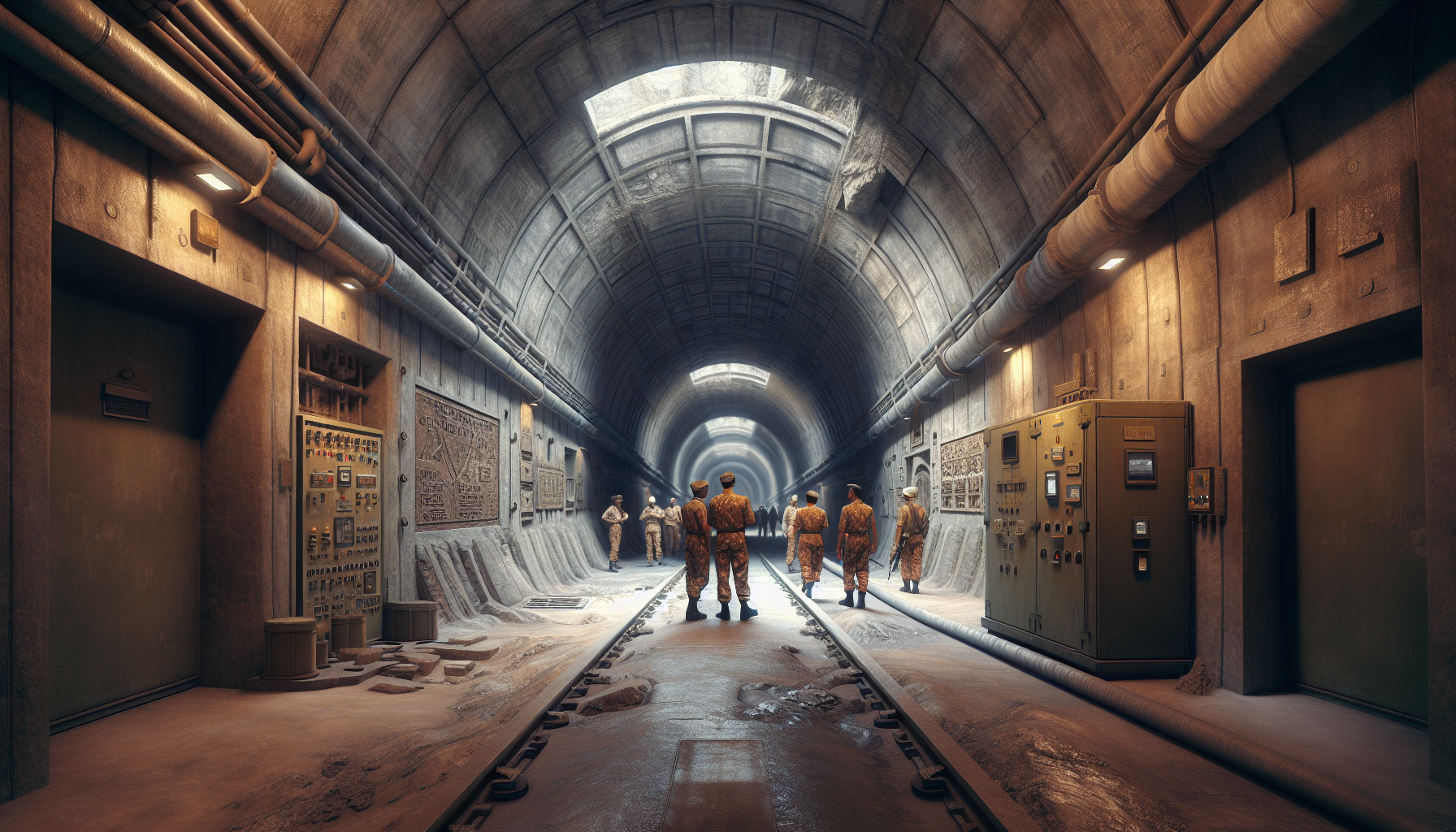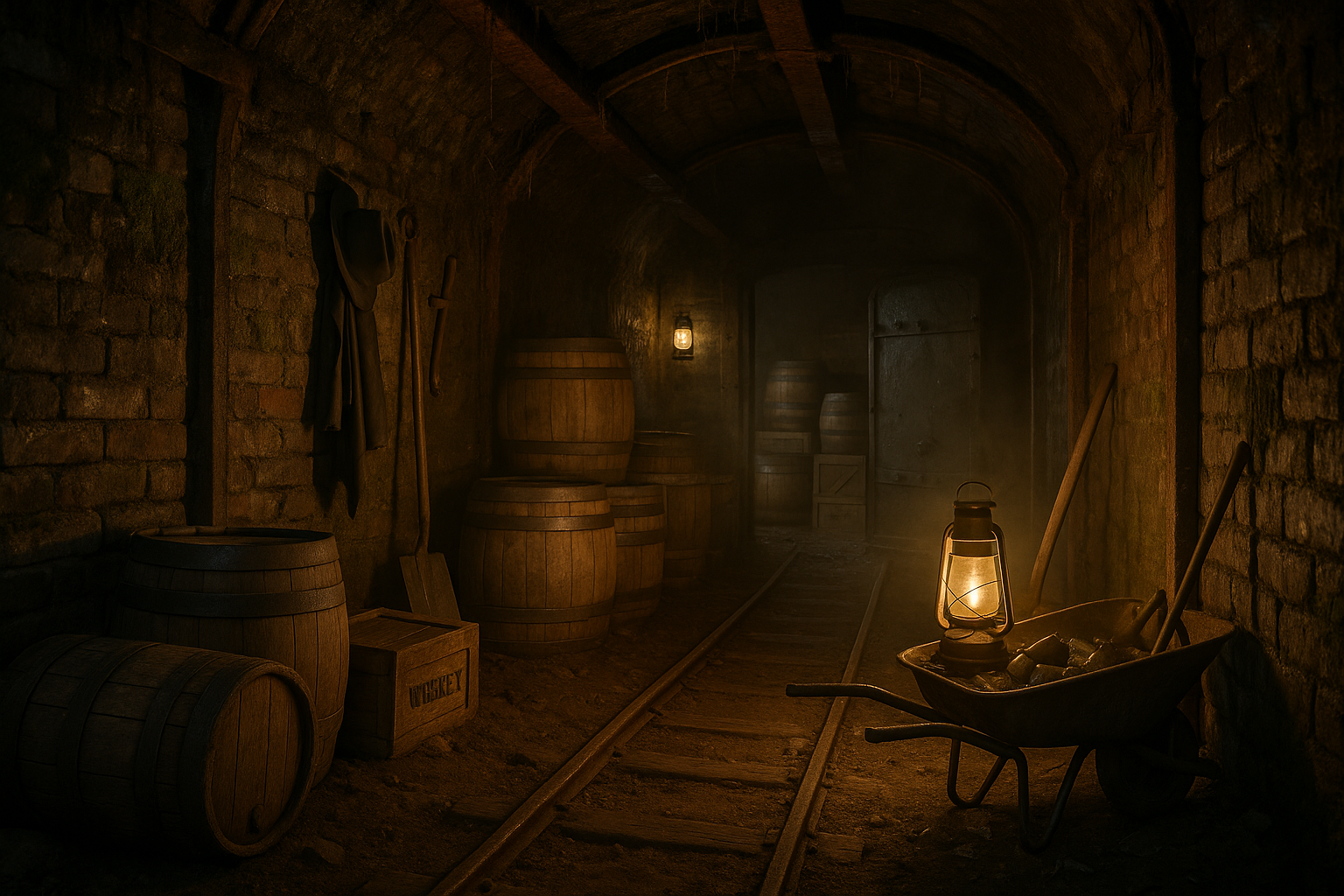In the shadowy world of military strategy, there are countless secrets hidden beneath the surface—literally. The earth beneath our feet often conceals more than just soil and rock; it harbors a world of underground military structures shrouded in mystery and intrigue. These subterranean facilities, some of which have been in existence for decades, play a crucial role in defense and security strategies across the globe. As you delve into the depths of this article, prepare to embark on a journey that uncovers the secrets of these enigmatic underground fortresses.
Underground military structures have long captivated the imagination of historians, conspiracy theorists, and curious minds alike. From the expansive bunkers designed to withstand nuclear fallout to intricate tunnel networks used for covert operations, these facilities are marvels of engineering and strategic planning. But what drives the need for such hidden fortresses? As we explore this topic, we’ll delve into the historical context that gave rise to these subterranean sanctuaries and examine the technological innovations that make them possible today.
One cannot ignore the fascinating stories that surround these hidden installations. Many of these underground structures were born out of the intense geopolitical tensions of the 20th century, particularly during the Cold War. As nations grappled with the looming threat of nuclear conflict, the race to build secure, hidden facilities became a top priority. We’ll explore some of the most famous—and infamous—underground military sites, from the United States’ Cheyenne Mountain Complex to the deeply buried Soviet bunkers scattered across Russia. 🏰 Each of these sites offers a unique glimpse into the fears and priorities of their time.
However, the allure of underground military structures extends beyond the Cold War era. In today’s world, as technological advancements continue to accelerate, the strategic importance of these facilities remains significant. Modern underground installations are often equipped with state-of-the-art technology, serving not only as secure command centers but also as hubs for intelligence and cyber warfare operations. We’ll investigate how contemporary military forces utilize these spaces in an era defined by digital threats and asymmetrical warfare, shedding light on their evolving role in national security.
As you read through this comprehensive exploration, you’ll gain insights into the engineering marvels that make these underground structures possible, the strategic calculations that drive their construction, and the ongoing relevance they hold in a rapidly changing world. Whether you’re a military enthusiast, a history buff, or simply intrigued by the hidden corners of our world, this article promises to reveal the unseen and uncover the unknown. So, prepare to descend into the depths of military secrecy, where the underground serves as both a shield and a sword in the global theater of conflict.
The Historical Context of Underground Military Structures
Throughout history, the military has always been at the forefront of innovation, often adopting groundbreaking technologies and strategies to gain an upper hand in warfare. One such innovation is the development of underground military structures. The use of subterranean spaces for military purposes dates back to ancient times, with historical records indicating that tunnels and bunkers were used during various wars and conflicts. These structures provided a strategic advantage by offering a level of concealment and protection against enemy forces. In the 20th century, the utilization of underground military bases and bunkers became more prevalent, especially during World War II and the Cold War, when the threat of aerial bombardments and nuclear warfare loomed large.
The significance of underground military installations increased exponentially during the Cold War era. Nations invested heavily in constructing complex underground facilities designed to withstand nuclear attacks. The need for secrecy and protection against espionage led to the development of elaborate underground networks. These structures were engineered to house critical command and control centers, weapon storage, and even living quarters for military personnel. The advancements in engineering and technology during this period allowed for the creation of underground facilities that could operate independently for extended periods.
The strategic importance of underground military bases continues in modern times, with countries like the United States, Russia, and China developing and maintaining these facilities. The ability to conceal military operations, protect critical assets, and ensure the continuity of government functions in the event of a crisis makes underground structures an essential component of national defense strategies. As technological capabilities evolve, so too does the complexity and sophistication of these hidden structures.
Engineering Marvels: The Design and Construction of Underground Bases
Constructing underground military structures presents unique engineering challenges that require innovative solutions. The process begins with selecting an appropriate location, which involves geological surveys to determine the suitability of the terrain. Factors such as soil stability, water table levels, and seismic activity are considered to ensure the safety and durability of the structure. Once a site is chosen, extensive excavation is required to create the subterranean spaces needed for the base. This involves the use of specialized machinery and techniques to remove vast quantities of earth and rock while maintaining structural integrity.
The design of underground military bases is often dictated by their intended purpose. Some facilities are designed as bunkers, providing shelter and protection for personnel and equipment, while others serve as command centers with advanced communication and monitoring systems. The construction process involves the use of reinforced concrete and steel to create blast-resistant structures capable of withstanding external threats. Additionally, the implementation of advanced ventilation, water, and power systems ensures the facility’s operational capabilities even in isolated conditions.
The complexity of these engineering feats is further exemplified by the incorporation of cutting-edge technologies such as automated defense systems, secure communication networks, and advanced surveillance capabilities. These features enhance the functionality of underground military bases, allowing them to operate as self-sustaining entities. The use of camouflage and concealment techniques, including artificial landscaping and electromagnetic shielding, further enhances the secrecy and security of these installations.
Comparative Analysis: Underground Military Bases Around the World
Underground military structures vary significantly across different countries, each with unique designs and strategic purposes. To understand the diversity and complexity of these facilities, a comparative analysis is useful. Below is a table showcasing some of the most notable underground military bases around the world:
| Country | Base Name | Main Function | Notable Features |
|---|---|---|---|
| United States | Cheyenne Mountain Complex | Command and Control Center | Blast-resistant doors, self-sustaining power and water supply |
| Russia | Yamantau Mountain | Undisclosed (speculated to be a nuclear bunker) | Extensive tunneling, high-security perimeter |
| China | Underground Great Wall | Nuclear Weapons Storage | Thousands of kilometers of tunnels, missile storage |
Each of these bases reflects the strategic priorities and technological capabilities of their respective nations. The Cheyenne Mountain Complex in the United States is a prime example of a command and control center, designed to monitor aerospace threats and coordinate defense operations. Its robust design includes blast-resistant doors and independent power and water supplies, allowing it to function autonomously during crises. In Russia, the Yamantau Mountain facility remains shrouded in secrecy, with speculations about its use as a nuclear bunker. Its extensive tunneling and high-security perimeter highlight its strategic importance.
China’s Underground Great Wall represents a vast network of tunnels designed to store and protect its nuclear arsenal. This facility demonstrates China’s focus on deterrence and defense against potential threats. The extensive length and complexity of the tunnel network make it one of the most formidable underground military installations globally. As seen in this analysis, underground military bases serve diverse purposes, from command centers to weapon storage, reflecting each nation’s defense strategy.
The Role of Technology in Enhancing Underground Military Capabilities
Technology plays a pivotal role in the development and operation of underground military bases. Advances in engineering, communication, and defense systems have transformed these facilities into highly sophisticated entities capable of supporting a wide range of military operations. One of the key technological advancements is the integration of secure communication networks, which enable seamless coordination between underground bases and external military units. These networks are designed to withstand cyber-attacks and maintain operational integrity in hostile environments.
The implementation of automated defense systems is another critical aspect of modern underground bases. These systems include advanced sensors, surveillance cameras, and automated weaponry that provide real-time threat detection and response capabilities. Such technologies enhance the security and resilience of underground facilities, ensuring they can operate effectively even in the face of external threats. The use of artificial intelligence and machine learning further augments the decision-making processes within these bases, allowing for more efficient resource allocation and threat assessment.
Moreover, the development of advanced materials and construction techniques has revolutionized the design and durability of underground structures. Innovations in reinforced concrete and steel composites have resulted in structures that can withstand significant blast impacts and seismic activity. The incorporation of electromagnetic shielding and stealth technologies further enhances the concealment and protection of these facilities. These technological advancements ensure that underground military bases remain a critical component of national defense strategies, capable of adapting to evolving threats and challenges.
Watch a related video about the construction of underground military bases:
Check out this insightful video: Underground Military Bases – Engineering Marvels (Channel: Military Tech)
Conclusion

Conclusion: Uncovering the Hidden: Military Secrets of Underground Structures
In our exploration of the clandestine world of underground military structures, we’ve ventured into a realm often shrouded in mystery and intrigue. These hidden fortifications, integral to national security, have played pivotal roles throughout history, offering refuge, strategic advantage, and a veil of secrecy. As we recap the essential elements discussed, it’s crucial to emphasize the enduring significance of these underground constructs and the lessons they impart.
To begin with, we delved into the historical context that spurred the development of underground military facilities. From ancient fortresses to modern bunkers, the evolution of these structures reflects humanity’s perpetual need to adapt and fortify. Notable examples, such as the Cu Chi Tunnels in Vietnam and the Cheyenne Mountain Complex in the United States, illustrate the ingenuity and resourcefulness employed in their creation. These sites not only underscore the strategic importance of subterranean architecture but also highlight the intersection of military necessity and engineering prowess.
Moreover, the technological advancements in constructing these facilities were explored, revealing a fascinating blend of engineering innovation and strategic foresight. From reinforced concrete to advanced ventilation systems, the engineering feats achieved underground are nothing short of remarkable. Such advancements not only ensured the survival of these structures under duress but also enhanced their functionality and operational efficiency. This aspect of our discussion underscores the symbiotic relationship between technological progress and military strategy.
The strategic significance of underground military structures cannot be overstated. Throughout various conflicts, these hidden fortifications have provided nations with a tactical edge, serving as command centers, storage facilities, and even deterrents against adversarial advances. The ability to conceal and protect critical assets beneath the earth’s surface remains a cornerstone of military strategy, offering a shield against both conventional and unconventional threats. This strategic advantage reinforces the notion that, even in an age of digital warfare, physical infrastructure retains its paramount importance.
As we transitioned to contemporary implications, the role of underground structures in modern military strategy was thoroughly examined. In an era characterized by rapid technological evolution and shifting geopolitical landscapes, these facilities continue to hold immense relevance. The growing emphasis on cybersecurity and electronic warfare further amplifies the need for secure and resilient underground installations. This dynamic interplay between traditional fortifications and cutting-edge technology serves as a testament to the adaptability and foresight inherent in military planning.
Furthermore, the ethical and environmental considerations surrounding the construction and maintenance of underground military structures were highlighted. As nations strive to balance security imperatives with environmental stewardship, the need for sustainable practices in subterranean architecture becomes increasingly apparent. The integration of eco-friendly materials and the minimization of ecological impact are essential components of responsible military planning. This aspect of our discussion invites readers to consider the broader implications of military infrastructure on our planet.
In reflecting upon the multifaceted nature of underground military structures, it becomes evident that their significance extends beyond the realm of warfare. These hidden fortifications serve as a testament to human ingenuity, resilience, and the relentless pursuit of security. They encapsulate the delicate balance between aggression and protection, innovation and preservation.
As we conclude our exploration, the importance of continued discourse on this subject cannot be emphasized enough. Understanding the historical, strategic, and ethical dimensions of underground military structures enriches our comprehension of global security dynamics. It also prompts us to consider the broader implications of military strategy in an interconnected world.
In light of this, we encourage you, our readers, to engage further with this topic. Whether through sharing insights, participating in discussions, or exploring related literature, your involvement contributes to a broader understanding of the complexities surrounding military infrastructure. Consider exploring resources such as the Federation of American Scientists for comprehensive insights into military strategy and infrastructure.
Ultimately, the hidden world of underground military structures offers a unique lens through which to view the intricate dance of power, technology, and strategy. By uncovering these secrets, we not only gain a deeper appreciation for the past but also equip ourselves with knowledge to navigate the challenges of the future. Let us remain vigilant, informed, and inspired as we continue to unravel the mysteries of the unseen. 🌍🔍
Thank you for joining us on this journey. We look forward to your thoughts and reflections. Please feel free to comment, share, or apply what you’ve learned as we collectively explore the hidden dimensions of military strategy.
- Explore the history and evolution of underground military structures.
- Understand the engineering challenges and technological advancements involved.
- Compare notable underground bases worldwide and their strategic roles.
- Discover the future potential of underground military technologies.
Toni Santos is a visual storyteller and artisan whose work explores the quiet power of what lies beneath. With a deep fascination for subterranean and hidden architecture, Toni uncovers the layers, voids, and forgotten spaces that shape our built environment from the shadows.
His art is a journey through the unseen — from ancient underground chambers to sealed passageways, service tunnels, and foundations buried in time. Each creation tells a story of silence, secrecy, and structure — revealing how absence and concealment can be just as meaningful as what’s visible above ground.
Whether working through visual compositions, architectural studies, or symbolic handcrafted pieces, Toni captures the soul of hidden spaces. His work bridges art and archaeology, blending design with discovery. Trained in visual design and traditional techniques, Toni creates with intention. His pieces don’t just depict — they interpret, inviting viewers to rethink what space, memory, and architecture mean when they’re hidden from view.
As the creative force behind Vizevex, Toni shares this perspective through curated visual narratives, symbolic collections, and interpretive essays that give voice to the quiet geometries beneath our feet.
His work is a tribute to:
The mystery of spaces built to be forgotten
The symbolism embedded in foundations, voids, and passageways
The timeless connection between human intention and hidden structure
Whether you’re an artist, an urban explorer, or someone fascinated by the unseen frameworks that support our world, Toni invites you into a realm where architecture becomes myth — one corridor, one layer, one buried story at a time.





